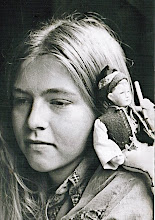On this postcard you can see The Ship on the left-hand side. Jessie was staying just down the street from The Ship where you see the X.
At the time this postcard was published, circa 1910, Greater Manchester had an extensive tram system. According to Wikipedia, the tram system provided 200 million passenger journeys per year by 1915 on 662 vehicles. At that time it was the most popular form of transportation. The tram system recovered quickly from damage during World War I, but was closed for a time in 1918 to stop the spread of the Spanish Flu.
In the 1940s, tracks were pulled up to provide steel for the war effort. As in many places, the trend was to abandon trams for buses. Salford tram service ended in 1947, with Manchester service ending just two years later.
Here's the back of the card, with Jessie's message:
Dear Leon
Where I have put that cross is the place Street I am staying in I often ride on the street car to town lovingly Jessie
Does the fact that she refers to the street car instead of a tram indicate that she was perhaps visiting from the United States?
You can view a video of Salford history and The Ship at Salford Online.
























